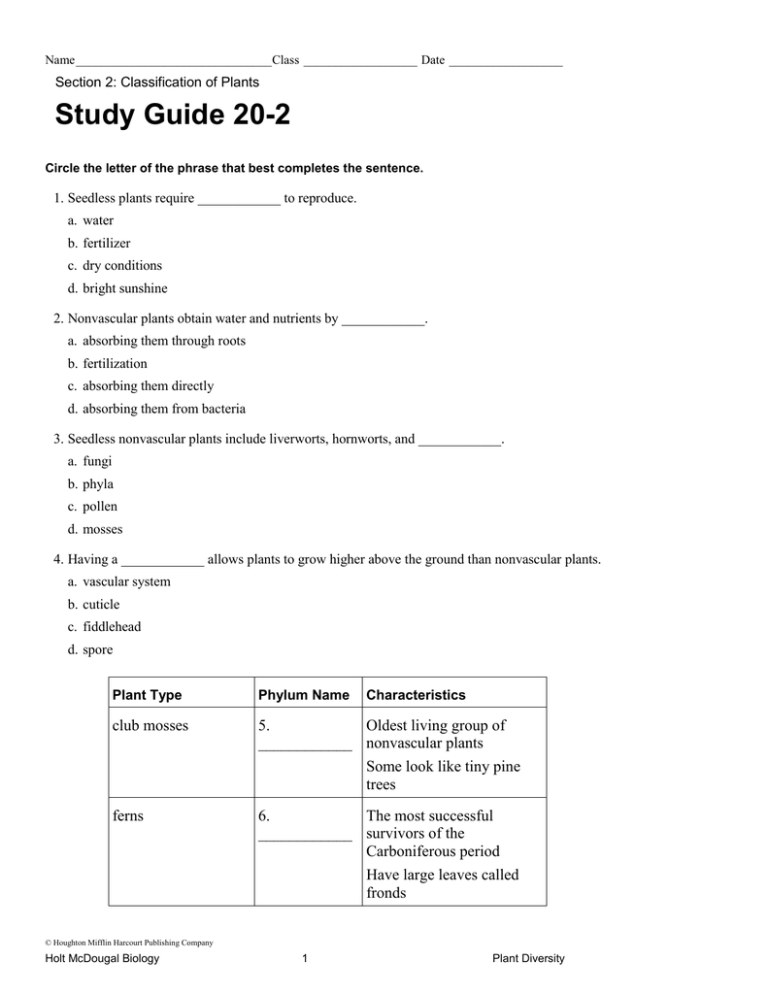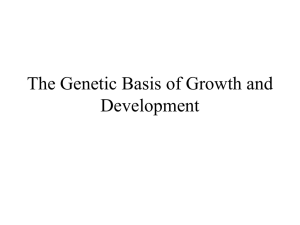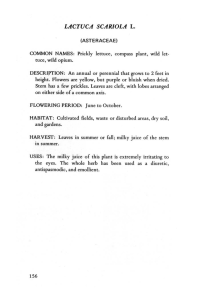chapter 20 section 2 and 3 study guides
advertisement

Name _______________________________Class __________________ Date __________________ Section 2: Classification of Plants Study Guide 20-2 Circle the letter of the phrase that best completes the sentence. 1. Seedless plants require ____________ to reproduce. a. water b. fertilizer c. dry conditions d. bright sunshine 2. Nonvascular plants obtain water and nutrients by ____________. a. absorbing them through roots b. fertilization c. absorbing them directly d. absorbing them from bacteria 3. Seedless nonvascular plants include liverworts, hornworts, and ____________. a. fungi b. phyla c. pollen d. mosses 4. Having a ____________ allows plants to grow higher above the ground than nonvascular plants. a. vascular system b. cuticle c. fiddlehead d. spore Plant Type Phylum Name Characteristics club mosses 5. Oldest living group of ____________ nonvascular plants Some look like tiny pine trees ferns 6. The most successful ____________ survivors of the Carboniferous period Have large leaves called fronds © Houghton Mifflin Harcourt Publishing Company Holt McDougal Biology 1 Plant Diversity Name _______________________________Class __________________ Date __________________ Study Guide A continued MAIN IDEA: Seed plants include cone-bearing plants and flowering plants. 7. _________ is the process that allows seed plants to reproduce without depending on water to carry sperm to eggs for fertilization. a. Pollination b. A vascular system c. Spore production d. A leaf cuticle Fill in the blanks with the phylum name of each group of seed plants described in the table below. Plant Type Phylum Name Characteristics cycads 8. _______________ Cone-bearing Provided food for dinosaurs ginkgo 9. _______________ Cone-bearing Only one living species conifers 10. _______________ Cone-bearing Trees with needle-like leaves flowering plants 11. _______________ pollination cone Produce flowers and fruit flower fruit Write the correct term from the box above next to the phrase that describes it. ______________ 12. mature ovary of flower ______________ 13. process in which pollen meets female parts of same plant species ______________ 14. reproductive structure of most gymnosperms ______________ 15. reproductive structure of angiosperms © Houghton Mifflin Harcourt Publishing Company Holt McDougal Biology 2 Plant Diversity Name ______________________________ Class ___________________ Date __________________ Section 3: Diversity of Flowering Plants Study Guide 20-3 MAIN IDEA: Flowering plants have unique adaptations that allow them to dominate in today’s world. Fill in the Concept Map below about the adaptations of flowering plants. Choose from the following terms and phrases: seed dispersal, flowers, fruit, pollination. Flowering plants have have 3. ________________ 1. ________________ which can allow for more efficient which plays a role in 2. ________________ 4. __________________ MAIN IDEA: Botanists classify flowering plants into two groups based on seed type. Fill in the boxes with the number of cotyledons found in each type of flowering plant. Type of Flowering Plant Number of Cotyledons Other Characteristics 5. monocot Long, narrow leaves with parallel veins 6. dicot Leaves with netlike veins © Houghton Mifflin Harcourt Publishing Company Holt McDougal Biology 1 Plant Diversity Name ______________________________ Class ___________________ Date __________________ Study Guide A continued MAIN IDEA: Flowering plants are also categorized by stem type and lifespan. 7. Flowering plants are categorized by seed type, stem type, and ____________. a. color b. lifespan c. shape d. pollination 8. Flowering plants that do not produce wood have ____________ stems. a. lignin b. thick c. woody d. herbaceous Complete the table by filling in the blanks with the plant lifespan that corresponds to each description. Lifespan Characteristics Examples 9. ___________ Entire lifespan takes place in one year Corn, lettuce, zinnias 10. ___________ Entire lifespan takes place in two years Carrots 11. ___________ Lifespan lasts more than two years Trees Vocabulary Check Fill in the blank with the word or phrase that best completes the sentence. 12. A(n) _____________________ is an embryonic leaf inside a seed. 13. ________________ is a fibrous material made of dead cells from a plant’s vascular system. © Houghton Mifflin Harcourt Publishing Company Holt McDougal Biology 2 Plant Diversity





